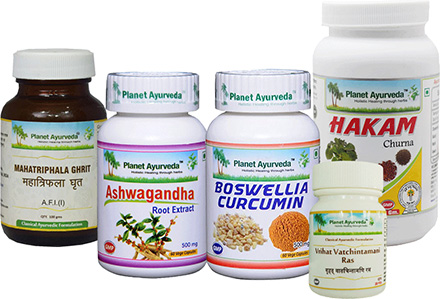What Is Pudendal Neuralgia? – Management and Prevention with Ayurveda
Abstract
Pudendal nerve is one of the main nerves present in the premium which helps in carrying sensation from the external genitalia of both sexes. It is also responsible for passing signals around the skin of the anus and also the motor supply to the different pelvic muscles which includes female and male external urethral sphincters. The damage of the pudendal nerve is commonly noticed in childbirth where fecal incontinence is very commonly seen. The Pudendal canal is responsible for carrying a pudendal nerve also known as alcock’s canal then it runs down in pairs meaning one from the left side and the other from the right side of the body. Sometimes the damage to the nerve results in shooting pain and one of the reasons for this disease is Pudendal neuralgia. So, today in this article we are going to discuss Pudendal neuralgia along with its herbal remedies.
What Is Pudendal Neuralgia?
Neuralgia simply refers to a condition where the person suffers from shooting pain due to damage of the specific nerve. This nerve condition can affect any of the nerves and the pudendal nerve is one of them that particularly affects the genitals and pelvis. In pudendal neuralgia, the pain usually stays for 2 minutes and then goes which is noted while passing urine or during sexual intercourse and sometimes while sitting down. It is not known how many people are affected but the cases of Pudendal Neuralgia are very rare

What Are The Signs And Symptoms?
The clinical feature noted in this disease is both radiating and local which includes symptoms like
- The most common symptom noted in the disease is that the patient suffers from pain in genital area along with numbness.
- In males, the pain is usually present on the base of the penis whereas In females the pain is noted in the vagina. This pain includes characteristics like stabbing, pricking, sharp, and shooting.
- Radiating pain in the buttocks that go to the legs and feet.
- Burning pain in the pelvic or the lumbar region is very commonly noted in patients.
- Feeling of numbness in the pelvic floor radiates all the way to the genitals.
- Swelling is also noted in the genital area.
- Dyspareunia meaning painful sex especially noted in females.
- Fecal incontinence where they always have the urge to pass stool.
Other symptoms
- Sweating
- Blood pressure
- Anxiety
- Increased heart rate
What Are The Causes For Pudendal Neuralgia?
The pudendal nerve can become compressed which then results in either permanent or temporary neuropathy. There are some triggering factors that are responsible for damaging the nerve either involving one side or both sides. The condition becomes irreversible when the nerve is stretched more than 12% of its original length
This divides the disease into an acute or chronic disorder
- Acute Pudendal Neuralgia can be caused by difficult childbirth.
- Chronic Pudendal Neuralgia is commonly noted in patients who suffer from constipation and it is very commonly seen in people who are professional cyclists.
- One of the reasons for the damage to the pudendal nerve is also related to the health disorders like multiple sclerosis and diabetes and in both conditions, the myelin sheath of the nerve is damaged resulting in irritation of the pudendal nerve.
- Pelvic surgery due to some tumor is also one of the causes resulting in permanent damage of the pudendal nerve.
- People who include heavy exercises like weight lifting, stretching or fracture to the pelvic floor is also one of the causes for Pudendal Neuralgia.
What Diagnosis Can Be?
To diagnose Pudendal neuralgia, you need to include clinical examinations like
- Physical examination:- Where pain is commonly seen in the Pudendal area and the pain becomes worse on sitting. You might also notice swelling in the genital area.
- MRI can also be done which will show compression to the pudendal nerve.
TREATMENT OF PUDENDAL NERVE
According to Allopaths, there is no specific treatment other than that they will prescribe pain killers which will only help in removing the symptoms but not the root cause of the disease. According to Ayurveda, the main cause for the development of Pudendal Neuralgia is the imbalance of the Vata and Pitta Dosha. Due to the violation of the Dosha, the nerve gets damaged resulting in pricking, stabbing, or shooting pain also known as the Vataj type of pain. It can be easily managed through herbal medicine which will help in reducing the symptoms and removing the cause by balancing the Dosha.

HERBAL MEDICINE PROVIDE BY PLANET AYURVEDA FOR PUDENDAL NEURALGIA
Planet Ayurveda provides herbal medicine that is 100 percent pure, natural, and vegetarian. All the herbal remedies are made under the supervision of MD Ayurvedic Doctors and they are all clinically tested. Each and every herbal medicine is free from chemicals, preservatives, and additives making them free from side-effects.
Here is the list of herbal medicine for Pudendal Neuralgia
- CHANDANADI VATI
- KAISHORE GUGGUL
- ASHWAGANDHA CAPSULES
- KAMDUDHA RAS MOTI YUKT
- CHANDERPRABHA VATI
- BOSWELLIA CURCUMIN
PRODUCT DESCRIPTION
1. CHANDANADI VATI
It is formed from the combination of herbs like
- Amalaki (Emblica officinalis)
- Shveta chandana (Santalum album)
- Gokshura (Tribulus terrestris)
- Maricha (Piper cubera) & many more
Dosage:- Two tablets twice daily with water after meals.
2. KAISHORE GUGGUL
These tablets are formulated with herbs like
- Guduchi (Tinospora cordifolia)
- Pippali (Piper longum)
- ginger (Zingiber officinale)
- Guggul (Commiphora mukul), etc
Kaishore guggul helps in balancing the Vata and Pitta dosha which is disturbed in the case of Pudendal neuralgia. It also helps in removing complaints like pain, burning sensation etc.
Dosage:- Two tablets twice daily after meals with water
3. ASHWAGANDHA CAPSULES
It is made from the single herb known as Ashwagandha (Withania somnifera) which is one of the best herbs providing the body with strength. Ashwagandha is one of the best tonics for nerves and helps in maintaining the tissue and muscles as well. It also helps in providing the body with physical stamina.
Dosage:- One capsule twice daily with water after meals.
4. KAMDUDHA RAS MOTI YUKT
It is helpful in balancing the Pitta Dosha and is useful in removing ailments like sweating, bleeding, vomiting, pain, etc which is very commonly noted in a patient with Pudendal Neuralgia. Kamdudha Ras Moti Yukt is very helpful in removing an infection from the urinary tract and gives strength to the nerves.
Dosage:- Two tablets twice daily with water after meals
5. CHANDERPRABHA VATI
It is one of the classical herbal medicine formulated with herbs like Guggul (Commiphora mukul), Haridra (Curcuma longa), Amalaki (Emblica officinalis), and many more other excellent herbs. This herbal formulation helps in boosting immunity and making the nerves very strong. It is suggested to be one of the best herbal formulations for any kind of neuralgic disorder.
Dosage:- Two tablets twice daily with water after meals.
6. BOSWELLIA CURCUMIN
This herbal medicine is made from two excellent herbs called Shallaki (Boswellia serrata) and Haridra (Curcuma longa). Both of the herbs are very useful in reducing the swelling of the genital area. Boswellia Curcumin is also found very useful in systemic sclerosis and diabetes which is also one of the causes of Pudendal Neuralgia.
Dosage:- Two capsules twice daily after meals with water.
Contact Planet Ayurveda to provide you the costing / ordering and delivery information at – costing.planetayurveda@gmail.com or call at +91-172-5214030 Or Check Website – www.PlanetAyurveda.com
Conclusion
Hence it is concluded that Pudendal Neuralgia is a painful and rare disorder. According to the modern method, there is no specific treatment but Ayurveda offers herbal medicine as mentioned above will help you in removing the root cause. The herbal remedy will not cause any complication instead it will remove the root cause of the disease.



